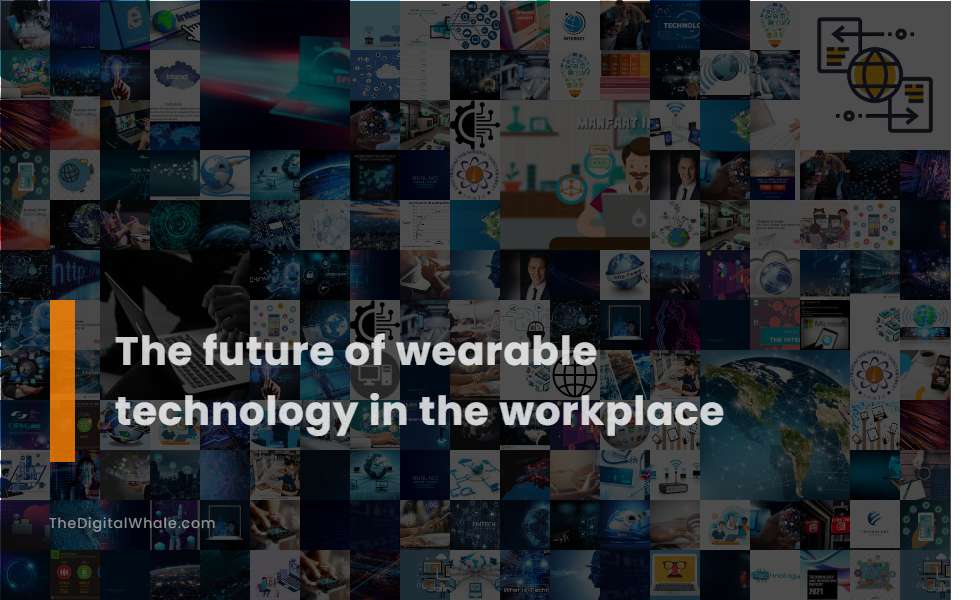The Future of Wearable Technology In the Workplace
How can wearables help organisations better track employees' work performance? What is the Potentially Super Creepy Future of Wearable Tech in the Workplace? Let's find out more about The Future of Wearable Technology In the Workplace.

Improved Productivity: Enhancing workplace efficiency through hands-free communication and task management.
Wearable technology in the workplace enhances productivity by enabling hands-free communication, optimizing workflows, and providing real-time notifications and access to pertinent information, leading to a significant boost in productivity and improved job satisfaction. These wearable devices streamline tasks by allowing workers to keep their hands and eyes free, using voice automation and hands-free workflows to reduce errors, improve time management, and increase efficiency in manual and hands-on jobs. For more insights on how wearable technology is transforming workplace dynamics, visit the Wearable Technology resource hub.
Enhanced Safety: Monitoring hazardous environments and alerting workers to potential dangers.
Wearable technology in the workplace is enhancing safety by monitoring hazardous environments and alerting workers to potential dangers through sensors that detect falls, changes in vital signs, and environmental hazards such as harmful gases or extreme temperatures. This advancement in technology, as highlighted on the Fisher Scientific website, significantly improves response times and prevents accidents, ensuring a safer and more proactive approach to workplace safety.
Employee Wellness Programs: Tracking health metrics and promoting wellness initiatives to reduce healthcare costs.
Wearable technology is transforming employee wellness programs by tracking vital health metrics like heart rate, sleep patterns, and physical activity. It provides real-time feedback and personalized insights that motivate positive behavior change, reduce healthcare costs, and enhance overall well-being through gamification, virtual coaching, and educational resources. By fostering a culture of health, Wearable Technology is revolutionizing workplace health, reducing healthcare costs, and increasing employee engagement through real-time data and tailored interventions. This leads to a healthier, more engaged, and productive workforce.
AI and Machine Learning Integration: Providing personalized health recommendations and predictive health alerts.
The future of Wearable Technology in the workplace involves the integration of AI and machine learning to provide personalized health recommendations and predictive health alerts. AI algorithms analyze real-time data from wearables to detect early signs of health issues, such as cardiovascular diseases or diabetes, and offer tailored health plans, fitness routines, and dietary suggestions based on individual data, enabling proactive healthcare and improved workplace well-being. To explore more about this exciting advancement, visit the insightful article on Wearable Technology, which delves into the transformative role of AI in real-time health tracking.
Augmented Reality (AR) and Virtual Reality (VR) Applications: Enhancing training, navigation, and information access.
Augmented Reality (AR) and Virtual Reality (VR) are transforming workplace training, navigation, and information access by providing immersive learning environments, real-time instructions, and enhanced collaboration. For example, companies like Walmart and Boeing use VR for training simulations, while AR is used to overlay instructions and safety information, improving efficiency and reducing errors. To explore more about how these technologies are reshaping industries, visit the Wear Studio website.
Related:
What are the implications of big data for equal employment opportunity? What are the legal risks associated with big data? Let's find out more about Big Data and Its Implications for Employers.
Exoskeletons and Powered Gloves: Physically assisting workers with tasks like lifting.
Exoskeletons and powered gloves are transforming workplace safety by physically assisting workers in tasks like lifting, reducing the risk of musculoskeletal injuries. These devices, such as exoskeleton suits and power gloves, provide support and enhance grip strength, with examples showing a significant reduction in lower back injuries and hand fatigue in industries like manufacturing, logistics, and construction. To learn more about how AI Wearable Technology is shaping the future of health and safety, explore the advancements taking place in various work environments.
Ergonomic Sensors: Alerting users to potentially unsafe movements and reducing injuries.
Wearable technology is revolutionizing workplace safety by incorporating advanced sensors that monitor and analyze employees' movements and posture in real-time. Ergonomic sensors are particularly pivotal in this transformation, offering immediate data that aids in preventing injuries and long-term health issues. For instance, the ViSafe+ wearable sensors provide intricate movement analysis, unearthing ergonomic and manual handling risks while verifying interventions aimed at reducing musculoskeletal injuries. Concurrently, StrongArm's SafeWork Sensor enhances safety measures by delivering real-time haptic feedback and collecting movement data. This approach facilitates actionable insights powered by artificial intelligence, thus driving personalized risk assessments and offering microlearning content to optimize workplace safety.
Smart Helmets: Incorporating physiological and environmental sensors to alert employees to accidents and hazards.
Smart helmets are enhancing workplace safety by integrating physiological and environmental sensors with GPS trackers, detecting falls, and alerting employees and medical teams to hazards such as excessive heat, high humidity, and the presence of dangerous gases, while also tracking vital signs and identifying risky behaviors. Businesses are advancing these technologies significantly, as detailed on the Innovation In Business website. These innovations are pivotal to ensuring a more secure and efficient environment for workers, leveraging cutting-edge technologies to maintain health and safety standards.
Real-Time Data Analytics: Connecting sensors to collect, exchange, and analyze data for improved safety and efficiency.
Wearable technology in the workplace is transforming safety and efficiency through real-time data analytics, enabling the collection, exchange, and analysis of data from sensors to monitor body posture, detect hazardous movements, and provide immediate alerts in case of injuries or incidents. This technological advancement significantly reduces worker strain and enhances operational efficiencies. To dive deeper into how wearable technology is making a difference, you can explore the detailed insights available at EHS Today, which discusses its impact on modern workplace environments.
5G and IoT Integration: Enabling faster and more reliable connectivity for seamless data transfer and enhanced performance.
The future of Wearable Technology in the workplace will be significantly enhanced by 5G and IoT integration, providing faster and more reliable connectivity for real-time data transfer, improved performance, and seamless integration with other devices and systems. This advancement will foster enhanced workplace safety, productivity, and employee wellness. The integration of 5G networks and IoT technologies will transform workplace health monitoring by enabling real-time data transmission, enhancing connectivity, and utilizing miniaturized sensors and smart textiles. To learn more about these trends and innovations, visit the IndustryWired website. This technological synergy is set to create a healthier, safer, and more productive work environment.
Related:
What are the future of work and life? What are the latest trends in AI and how will they affect the future of employment? Let's find out more about The Rise of Ai and Its Impact On Jobs.
